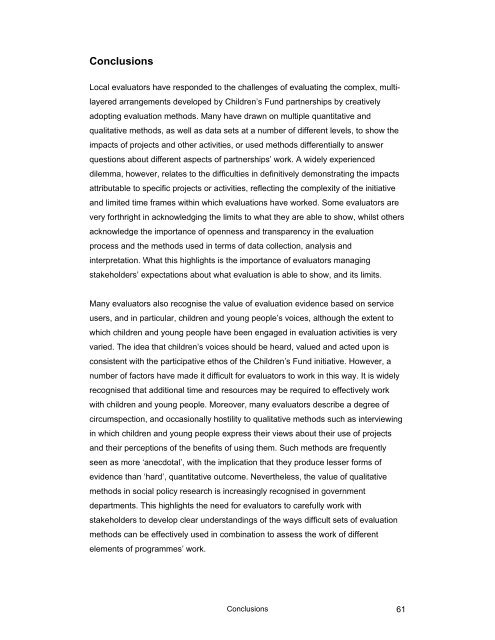Local Evaluation of Children's Services Learning from the Children's ...
Local Evaluation of Children's Services Learning from the Children's ...
Local Evaluation of Children's Services Learning from the Children's ...
- No tags were found...
Create successful ePaper yourself
Turn your PDF publications into a flip-book with our unique Google optimized e-Paper software.
Conclusions<strong>Local</strong> evaluators have responded to <strong>the</strong> challenges <strong>of</strong> evaluating <strong>the</strong> complex, multilayeredarrangements developed by Children’s Fund partnerships by creativelyadopting evaluation methods. Many have drawn on multiple quantitative andqualitative methods, as well as data sets at a number <strong>of</strong> different levels, to show <strong>the</strong>impacts <strong>of</strong> projects and o<strong>the</strong>r activities, or used methods differentially to answerquestions about different aspects <strong>of</strong> partnerships’ work. A widely experienceddilemma, however, relates to <strong>the</strong> difficulties in definitively demonstrating <strong>the</strong> impactsattributable to specific projects or activities, reflecting <strong>the</strong> complexity <strong>of</strong> <strong>the</strong> initiativeand limited time frames within which evaluations have worked. Some evaluators arevery forthright in acknowledging <strong>the</strong> limits to what <strong>the</strong>y are able to show, whilst o<strong>the</strong>rsacknowledge <strong>the</strong> importance <strong>of</strong> openness and transparency in <strong>the</strong> evaluationprocess and <strong>the</strong> methods used in terms <strong>of</strong> data collection, analysis andinterpretation. What this highlights is <strong>the</strong> importance <strong>of</strong> evaluators managingstakeholders’ expectations about what evaluation is able to show, and its limits.Many evaluators also recognise <strong>the</strong> value <strong>of</strong> evaluation evidence based on serviceusers, and in particular, children and young people’s voices, although <strong>the</strong> extent towhich children and young people have been engaged in evaluation activities is veryvaried. The idea that children’s voices should be heard, valued and acted upon isconsistent with <strong>the</strong> participative ethos <strong>of</strong> <strong>the</strong> Children’s Fund initiative. However, anumber <strong>of</strong> factors have made it difficult for evaluators to work in this way. It is widelyrecognised that additional time and resources may be required to effectively workwith children and young people. Moreover, many evaluators describe a degree <strong>of</strong>circumspection, and occasionally hostility to qualitative methods such as interviewingin which children and young people express <strong>the</strong>ir views about <strong>the</strong>ir use <strong>of</strong> projectsand <strong>the</strong>ir perceptions <strong>of</strong> <strong>the</strong> benefits <strong>of</strong> using <strong>the</strong>m. Such methods are frequentlyseen as more ‘anecdotal’, with <strong>the</strong> implication that <strong>the</strong>y produce lesser forms <strong>of</strong>evidence than ‘hard’, quantitative outcome. Never<strong>the</strong>less, <strong>the</strong> value <strong>of</strong> qualitativemethods in social policy research is increasingly recognised in governmentdepartments. This highlights <strong>the</strong> need for evaluators to carefully work withstakeholders to develop clear understandings <strong>of</strong> <strong>the</strong> ways difficult sets <strong>of</strong> evaluationmethods can be effectively used in combination to assess <strong>the</strong> work <strong>of</strong> differentelements <strong>of</strong> programmes’ work.Conclusions 61
















